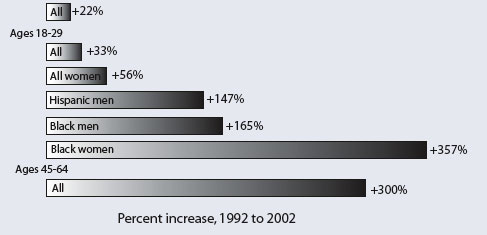 |

By Patrick Zickler, NIDA NOTES Staff Writer
More Americans suffer from marijuana-related disorders now than a decade ago, even though the prevalence of marijuana smoking has not increased. Survey results from 2002, compared with data from a decade earlier, showed that overall, rates of marijuana consumption in adults 18 and older held relatively steady at 4 percent of respondents. However, rates of marijuana-related disorders—discrete conditions defined according to criteria established by the American Psychiatric Association—increased from 1.2 percent to 1.5 percent of respondents, or from 30.2 percent overall to 35.6 percent among marijuana smokers. The increase was particularly sharp among young adult black men and women aged 18-29, among whom marijuana consumption rose only modestly while the prevalence of disorders tripled. Rates of marijuana-related disorders among Hispanic men in the same age span also increased sharply despite only a moderate increase in their rate of marijuana smoking.
"The rise in marijuana-related disorders means that there were approximately 800,000 more adults in the United States with marijuana abuse or dependence in 2002 than a decade earlier," says Dr. Wilson Compton of NIDA's Division of Epidemiology, Services and Prevention Research. "In the 1992 survey, these problems were more common among Whites than among minorities, but in 2002 the differences in rates among the different ethnic groups had narrowed, in large part because of a rate that more than tripled among young African American men and women and more than doubled among young Hispanic men."
Dr. Compton and colleagues at NIDA, and Dr. Bridget Grant and colleagues at the National Institute on Alcohol Abuse and Alcoholism (NIAAA), evaluated data from two large, national epidemiologic surveys—the National Longitudinal Alcohol Epidemiologic Survey (NLAES), conducted in 1991-1992, and the National Epidemiological Survey on Alcohol and Related Conditions (NESARC), conducted in 2001-2002. Both studies define abuse and dependence using criteria that match the diagnostic standards found in the Diagnostic and Statistical Manual of Mental Disorders, 4th Edition (DSM-IV); see "Defining Marijuana-Related Disorders."
| Older Americans, Young Blacks, and Hispanic Men Show Largest Increases in Rates of Marijuana-Related Disorders |
 Survey data collected 1991-1992 and 2001-2002 show little increase over the decade in rates of marijuana smoking, but overall prevalence of marijuana-related disorders increased by 22 percent. Increases in a few demographic groups accounted for most of this increase. |
|
The study also reveals a shift in marijuana use and its associated problems among older adults, Dr. Compton says. "Marijuana smoking increased by 167 percent and the prevalence of marijuana-related disorders quadrupled among men and women aged 45 to 64," he observes. "Given this shift, the possibility that marijuana may contribute to health problems among the aging population deserves research attention."
The surveys do not explain why disorders increased in some groups and not in others. However, increased potency of marijuana in the last decade may be partly responsible for the overall upward trend of marijuana-related disorders, the researchers speculate. Regardless of the causes, the sharp increases among minority groups merit further investigation, Dr. Compton says. "We see what could be described as a possible epidemic of marijuana-related disorders among young adult minorities. It probably has been going on undetected for years, and points to the need for specifically targeted prevention and intervention efforts."
Source:
- Compton, W.M., et al. Prevalence of marijuana use disorders in the United States: 1991-1992 and 2001-2002. JAMA 291(17):2114-2121, 2004.
[Abstract]
Defining Marijuana-Related Disorders
"Although the American Psychiatric Association's DSM-IV was not published until 1994, proposed diagnostic criteria for marijuana abuse and dependence had been circulated earlier," says Dr. Bridget Grant of NIAAA, who was the principal investigator of the National Longitudinal Alcohol Epidemiologic Survey fieldwork and, a decade later, in the National Epidemiologic Survey on Alcohol and Related Conditions. "These criteria were incorporated in their entirety into the structured interview used in both surveys." Survey respondents were considered to be suffering a marijuana-related disorder if they met DSM-IV diagnostic criteria for either abuse or dependence.
Marijuana abuse
A respondent had to report experiencing at least 1 of the following
4 criteria in the 12 months preceding the survey:
- Recurrent marijuana use resulting in failure to fulfill major role obligations;
- Recurrent marijuana use in physically hazardous situations;
- Recurrent marijuana-related legal problems; and
- Continued use despite recurrent or persistent social or interpersonal
problems caused or exacerbated by marijuana use.
Marijuana dependence
This disorder's diagnosis required respondents to report past-year experience of at least 3 of the following 6 criteria:
- Need for increased amounts of marijuana to achieve desired effect;
- Use of marijuana in larger amounts or over longer periods than intended;
- Persistent desire or unsuccessful efforts to cut down marijuana use;
- A great deal of time spent obtaining, using, or recovering from the effects of marijuana;
- Giving up important social, occupational, or recreational activities in favor of using marijuana; and
- Continued use despite persistent or recurrent physical or psychological problems caused or exacerbated by use.
|
Volume 19, Number 6 (May 2005)
|
 |
|